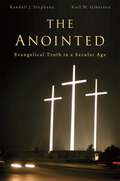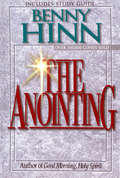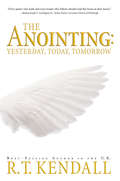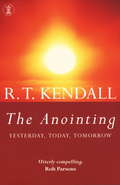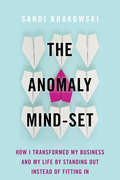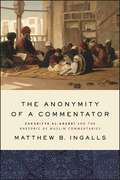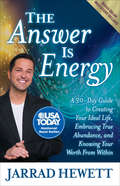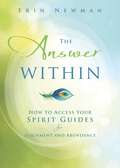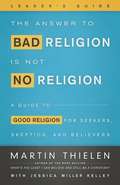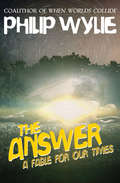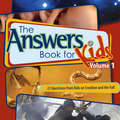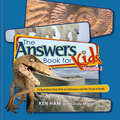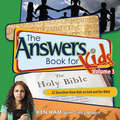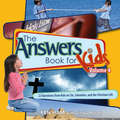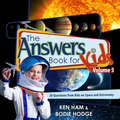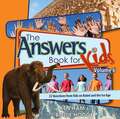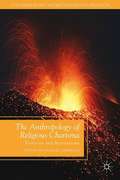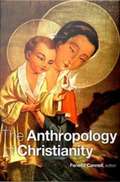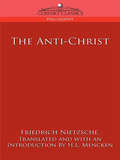- Table View
- List View
The Anointed: Evangelical Truth in a Secular Age
by Randall J. Stephens Karl W. GibersonAmerican evangelicalism often appears as a politically monolithic, textbook red-state fundamentalism that elected George W. Bush, opposes gay marriage, abortion, and evolution, and promotes apathy about global warming. Prominent public figures hold forth on these topics, speaking with great authority for millions of followers. Authors Stephens and Giberson, with roots in the evangelical tradition, argue that this popular impression understates the diversity within evangelicalism an often insular world where serious disagreements are invisible to secular and religiously liberal media consumers. Yet, in the face of this diversity, why do so many people follow leaders with dubious credentials when they have other options? Why do tens of millions of Americans prefer to get their science from Ken Ham, founder of the creationist Answers in Genesis, who has no scientific expertise, rather than from his fellow evangelical Francis Collins, current Director of the National Institutes of Health? Exploring intellectual authority within evangelicalism, the authors reveal how America s populist ideals, anti-intellectualism, and religious free market, along with the concept of anointing being chosen by God to speak for him like the biblical prophets established a conservative evangelical leadership isolated from the world of secular arts and sciences. Today, charismatic and media-savvy creationists, historians, psychologists, and biblical exegetes continue to receive more funding and airtime than their more qualified counterparts. Though a growing minority of evangelicals engage with contemporary scholarship, the community s authority structure still encourages the anointed to assume positions of leadership.
The Anointing
by R. T. KendallAnointing. While the word has several meanings in the Bible, it always revolves around the idea of the Holy Spirit and His power to change human lives. Each of us has an anointing or a special gift from God. Using it properly is the key to creating what is good, blessing and encouraging others, edifying ourselves, and pleasing the Lord.
The Anointing: Yesterday, Today and Tomorrow
by R.T. KendallFresh ANOINTING for you TodayDo you have a fear of being a "has-been"? Although you may long to be blessed by the anointing of the Holy Spirit, R.T. Kendall believes it is possible to abuse this anointing- and become yesterday's man or woman. This happens by trying to move outside your calling and capabilities, for example, or even through impatience. Drawing on the Bible, especially the lives of Saul, Samuel and David, as well as his own experience, he helps you to identify your current usefulness and urges you to seek a fresh anointing of the Holy Spirit each day. God wants to give His anointing to everyone. But have you stepped into your fullness and potential? Don't let your past ruin what God has for you today. Don't be too busy to hear His voice. Learn how to wait patiently for God's perfect timing and the promotion tht will be here tomorrow. The fresh anointing is available to you...right now. "The material within this book is not only unique; it is superb. You will benefit from reading it the first time, but you will be changed by reading it more than once." Michael Youssef The Church of the Apostles, Atlanta, Georgia "R.T. Kendall takes us into, as the prophet Ezekiel says, 'waters to swim in'! Read with spiritual ears wide open; God's Spirit will speak-He really will!" Paul F. Crouch, President Trinity Broadcasting Network
The Anointing: Yesterday, Today, Tomorrow
by R.T. KendallAlthough many of us long to be blessed by the anointing of the Holy Spirit, R. T. Kendall believes it is possible to abuse this anointing - and become yesterday's man or woman. This happens by trying to move outside our calling and capabilities, for example, or even through impatience.Drawing on the Bible, especially the lives of Saul, Samuel and David, as well as on his own experience, R. T. helps us to identify our current usefulness and urges us to seek a fresh anointing of the Holy Spirit each day.
The Anointing: Yesterday, Today, Tomorrow
by R.T. KendallAlthough many of us long to be blessed by the anointing of the Holy Spirit, R. T. Kendall believes it is possible to abuse this anointing - and become yesterday's man or woman. This happens by trying to move outside our calling and capabilities, for example, or even through impatience.Drawing on the Bible, especially the lives of Saul, Samuel and David, as well as on his own experience, R. T. helps us to identify our current usefulness and urges us to seek a fresh anointing of the Holy Spirit each day.
The Anomaly Mind-Set: How I Transformed My Business and My Life by Standing Out Instead of Fitting In
by Sandi KrakowskiPowerhouse social media influencer and online marketing and business development expert offers inspiration and hands-on tools for readers to follow their dreams and understand why not fitting in is their biggest asset.Bringing your whole, true self to your work, including your body, soul, and spirit--and allowing your faith to be part of your day in your workplace--lets you express your fullest potential and be as successful as possible in the world.Sandi Krakowski found early on that, as she put it, she had "too much God" in her for the workplace and "too much money and business" in her for churches. That made her an anomaly, but it also unlocked her greatest potential: if nobody was doing it her way, she'd find a new way to do things. Her success has been proven time and again in the companies she's founded and sold, and in the groundbreaking social media marketing she's done that engages with her followers to where they all plainly feel they know her intimately. Her current business, A Real Change, inspires people to live their fullest, most successful life, on all levels.In her new book, Sandi will offer all the inspiration and the real, hands-on tools to inspire everyone to follow their dreams, fulfil their real potential, and not leave any part of their soul or spirit behind them on this workplace journey. Every chapter is jam-packed with inspirational stories in her inimitable voice, exploring the ways that each of us can have an impact every day, with tips, takeaways, and "Anomaly Actions" to spur every reader to take power in their own work and spiritual lives right away.Sandi shows on every page how to break past those doubting voices, both in your own head and out in the world, bucking the system and learning to find the absolutely limitless growth that comes from choosing faith over fear.
The Anonymity of a Commentator: Zakariyyā al-Anṣārī and the Rhetoric of Muslim Commentaries (SUNY series in Islam)
by Matthew B. IngallsThe Anonymity of a Commentator examines the life and writings of the Egyptian Sufi-scholar Zakariyyā al-Anṣārī (d. 926/1520), the longest-serving chief Shāfi'ī justice to the Mamlūk sultanate during its final years. It analyzes al-Anṣārī's commentaries in the disciplines of Sufism and Islamic law as a case study to illustrate how and why Muslims produced commentaries in the later Islamic Middle Period and how the form and rhetoric of commentary writing furnished scholars like al-Anṣārī with a medium in which to express their creativity and adapt the received tradition to the needs of their time. Whereas twentieth-century scholars tended to view Muslim commentary texts as symbols of intellectual stagnation in and of themselves, contemporary scholars recognize that these texts are often the repositories of profound ideas, although they approach them with little guidance from their academic predecessors. The Anonymity of a Commentator aims to provide this guidance, through a close study of one of the most prolific commentary writers in Islamic history.
The Anonymous Sayings of the Desert Fathers
by John WortleyThe Tales and Sayings of the Desert Fathers (Apophthegmata Patrum) are a key source of evidence for the practice and theory respectively of eremitic monasticism, a significant phenomenon within the early history of Christianity. The publication of this book finally ensures the availability of all three major collections which constitute the work, edited and translated into English. Richer in Tales than the 'Alphabetic' collection to which this is an appendix (both to be dated c. AD 500), the 'Anonymous' collection presented in this volume furnishes almost as much material for the study of the late antique world from which the monk sought to escape as it does for the monastic endeavour itself. More material continued to be added well into the seventh century and so the spread and gradual evolution of monasticism are illustrated here over a period of about two and a half centuries.
The Answer Is Energy: A Thirty-Day Guide to Creating Your Ideal Life, Embracing True Abundance, and Knowing Your Worth From Within
by Jarrad HewettThis USA Today–bestselling guide is &“a powerful roadmap readers can follow to achieve true abundance, productivity, and joy&” (Seattle Post-Intelligencer). People from all walks of life are waking up to questions of &“Who am I?&” &“What is my purpose, and how can I move from places of lack, dis-harmony, dis-ease, and anger into joy, abundance, vitality, love, wholeness, and harmony—fast?&”The Answer Is Energy. In this book, multi-dimensional energy expert Jarrad Hewett shares stories that reveal how to shift energy and reframe thinking about family, money, relationships, abundance, and control to live in the moment of now. When someone&’s energy is in alignment with their true intention of being healthier, happier, and more productive, great empowerment and life changing transformation occurs. Jarrad shows readers how energy creates with thoughts, feelings, and beliefs. He also teaches how to quickly shift into a paradigm of ease, bliss, love, abundance, and tranquility.The Answer is Energy can help readers seize their best life by showing them how not to let their inner programming and the worn-out stories of their past crowd out their dreams and aspirations. People are continually looking for solutions &“out there,&” but this book shows that they have all the resources and tools inside themselves to tap into their own abundant source of energy and catapult their lives into the stratosphere. So, let&’s get started.
The Answer Is Simple#Love Yourself, Live Your Spirit!: Love Yourself!
by QHaving observed thousands and thousands of people from virtually every walk of life, with every advantage or disadvantage, Sonia Choquette can confidently say that the only ones who genuinely succeed, who find peace and joy in their hearts and take great pleasure in their experiences, have a different way of going about things. Rather than relying solely on their egos—their defended, insecure personalities—suffering the assaults life renders them, they turn to a higher aspect of their nature, the Spirit within, and let this direct their lives. <p><p>The ten simple yet necessary steps outlined in this book will allow you to make that connection to your authentic Spirit and experience your truth. As Sonia says, "These aren’t just metaphysical theories, but are tried-and-true, grounded practices that will lead you directly back to you: the best, holiest, most delightful and delighted you, free of fear and filled with light." <p><p>The most exciting part is that learning to love yourself and live your Spirit is actually quite simple when you realize the truth revealed herein: that you are not the ego, but rather are Divine, Holy Spirit. Once you do, everything will come alive in light and joy. Love yourself and live your Spirit, and your life flows peacefully. It really is that simple
The Answer Within: How to Access Your Spirit Guides for Alignment and Abundance
by Erin NewmanAlign with Your True Purpose and Create Your Unique Version of SuccessFind the answers to all your important, real-world questions by connecting with your spirit guides. Erin Newman teaches you how to safely work with them in a non-appropriative way, regardless of your background or belief system. These guides help you make money doing what you love, relieve physical pain, cultivate kindness, heal ancestral patterns, and more.Erin presents nearly thirty hands-on prompts that support all aspects of your life and give you the wisdom to move forward despite obstacles. By journeying to your spirit guides, you'll become more compassionate and release blocks along your sacred path. Perfect for any experience level, this easy-to-use book encourages you to align with your deeper purpose and bring the magical back into the practical.
The Answer to Anxiety: How to Break Free from the Tyranny of Anxious Thoughts and Worry
by Joyce MeyerRenowned Bible teacher and #1 New York Times bestselling author Joyce Meyer teaches readers how to overcome anxiety by giving their worries to God. We all feel anxious, worried, or concerned at times; these feelings are common responses to stressful situations. But what if there was a way to put a stop to your worrying before it steals your peace of mind? In The Answer to Anxiety, renowned Bible teacher and #1 New York Times bestselling author Joyce Meyer reveals truth from God&’s Word that shows us how to focus on God when we&’re feeling anxious or unsettled. She also teaches readers practical steps based on Scripture that we can take when we need to face our fears and resolve all of our anxieties. God doesn&’t want you to live with worry and anxiety. And when you understand that He has a good plan for you, you can experience the life-changing peace He offers. Join Joyce on this journey to overcome anxiety and discover how you can have a God-centered, peace-filled life you enjoy every day. A Spanish edition, La respuesta a la ansiedad, is also available for purchase.
The Answer to Bad Religion Is Not No Religion
by Martin ThielenIn an effort to help those who've been hurt by or turned off by negative religion, Martin Thielen explains that there is an alternative to abandoning religion: good religion. Perfect for group study, the leader's guide provides everything needed to facilitate sessions and provide options based on the time and style of each group.
The Answer to Bad Religion Is Not No Religion Leader's Guide
by Martin ThielenIn an effort to help those who've been hurt by or turned off by negative religion, Martin Thielen explains that there is an alternative to abandoning religion: good religion. Perfect for group study, the leader's guide provides everything needed to facilitate sessions and provide options based on the time and style of each group.
The Answer: A Fable for Our Times
by Philip WylieIn this ingenious and unforgettable twentieth-century parable, a world on the brink of war is thrown into chaos when angels fall from heaven Major General Marcus Scott is a seasoned veteran of combat, a loyal American, and a skeptic in a volatile world. But amid the aftermath of a nuclear weapons test in the South Pacific, everything Scott believes—and refuses to believe—will be turned upside down. In a pool of clear water lies a single casualty of the blast, a beautiful winged being certainly not of this earth. And when a second celestial creature is discovered following a Russian H-bomb test, the military establishments of two major powers are thrown into chaos. Sworn enemies, each pledged to the other&’s destruction, they must now deal with the unthinkable and the impossible: that the Cold War has transcended the boundaries of the world, reaching into heaven to bring down angels. A provocative tale as beguiling as it is disturbing, Philip Wylie&’s The Answer is a captivating fantasy of the nuclear age. Set at the height of the United States–Soviet arms race, it is a page-turning thriller that taps into the anxieties and paranoia of a bygone era, offering a heartfelt plea for peaceful coexistence while decrying the suicidal insanity of war.
The Answers Book for Kids Volume 1
by Ken Ham Cindy MalottThe story of Creation and Adam and Eve in the Garden of Eden are familiar Bible stories. But they also present a wonderful opportunity to share important biblical truths with eagerly questioning minds through answers that even the youngest believer can understand. Look inside to learn: How did God create everything from nothing? Why was the first person that God created a boy? Why did God have Adam name the animals? The serpent talked to Eve, so why can't snakes talk today? Children are never short of questions - and now there are answers to some of their most difficult ones regarding the Bible and faith! The new Answers Book for Kids series is a unique collection from Ken Ham and the creative team at Answers in Genesis. These answers will help you to impart a Biblical Worldview to Elementary aged students in your Church or Homeschool. This is the 1st book of a 4 volume set.
The Answers Book for Kids Volume 2
by Ken Ham Cindy MalottDinosaurs are fascinating creatures that kids simply adore, and even the youngest believer can recite the biblical story of Noah and his ark. Now discover how to answer some of kids' most interesting questions about dinosaurs and Noah's ark like: How did all the dinosaurs fit on the ark? How did Noah keep the animals on the ark from eating each other and his family? Where did all the water go after the Flood? Why aren't there fossils of humans from Noah's flood? Answers are important. If children aren't given answers to their questions about the Bible and the history it reveals, they cannot defend their faith against a secular worldview in a fallen world. The new Answers Book for Kids series is a unique collection from Ken Ham and the creative team at Answers in Genesis. This is a necessary resource in your homeschool or Church's Sunday School. This is the 2nd book of a 4 volume set.
The Answers Book for Kids Volume 3
by Ken Ham Cindy MalottEven adults struggle to understand our Creator - the infinite Being who seeks a personal relationship with each of us. Now children can begin to understand both God's Holy Word and the importance of Him in their lives - what He expects from them, why it is vital to follow His plan for their lives, and the love He has for them. Open the book and discover: Why can't I hear God talking to me? How big is God? What does God look like? Why do I get in trouble at school when I talk about the Bible? These important answers will empower children to live with godly values and help them to understand why it is so important that they obey God. The new Answers Book for Kids series is a unique collection from Ken Ham and the creative team at Answers in Genesis. This set is an ideal resource for your elementary homeschool or your Church library. This is the 3rd book of a 4-volume set.
The Answers Book for Kids Volume 4
by Ken Ham Cindy MalottAt the heart of the Bible is the theme sin, salvation through Christ, and guidance for living the kind of life that honors our Creator God. Since Adam and Eve chose to disobey in the Garden of Eden, questions about sin, salvation, and the Christian life have faced humanity, so turn the pages to find the answers: What is heaven going to be like? Why does God let bad guys win sometimes? What does being "born again" mean? Why doesn't God keep me from being sick or hurt? This book gives Elementary aged children vital answers to help them form a strong and lasting faith foundation. The new Answers Book for Kids series is a unique collection from Ken Ham and the creative team at Answers in Genesis. These books are a great way to help children form a Biblical Worldview and lasting Godly values in your homeschool or your church's Sunday School. This is the 4th book of a 4 volume set.
The Answers Book for Kids Volume 5
by Ken Ham Bodie HodgeNever short of questions, let these titles bring answers to children who may just want to know, or who may be struggling in their walk with Christ. Parents and teachers need not be afraid of hte tough questions with these solid aplogetics titles in The Answers Book for Kids series. Too many children have grown up and left the Church because they asked tough questions and no one seemed to have an answer. Now, here are those answers! What day were planets created? Is it possible that there are living things in space? What about the big bang?
The Answers Book for Kids Volume 6
by Ken Ham Bodie HodgeNever short of questions, let these titles bring answers to children who may just want to know, or who may be struggling in their walk with Christ. Parents and teachers need not be afraid of hte tough questions with these solid aplogetics titles in The Answers Book for Kids series. Too many children have grown up and left the Church because they asked tough questions and no one seemed to have an answer. Now, here are those answers! Where was the Tower of Babel built? How many languages came from Babel? Have you ever found a frozen person from the Ice Age?
The Anthropology Of Religious Charisma
by Charles LindholmAccording to Max Weber, charisma is opposed to bureaucratic order. This collection reveals the limits of that formula. The contributors show how charisma is a part of cultural frameworks while retaining its ecstatic character among American and Italian Catholics, Syrian Sufis, Taiwanese Buddhists, Hassidic Jews, and Amazonian shamans, among others.
The Anthropology of Christianity
by Fenella CannellThis collection provides vivid ethnographic explorations of particular, local Christianities as they are experienced by different groups around the world. At the same time, the contributors, all anthropologists, rethink the vexed relationship between anthropology and Christianity. As Fenella Cannell contends in her powerful introduction, Christianity is the critical "repressed" of anthropology. To a great extent, anthropology first defined itself as a rational, empirically based enterprise quite different from theology. The theology it repudiated was, for the most part, Christian. Cannell asserts that anthropological theory carries within it ideas profoundly shaped by this rejection. Because of this, anthropology has been less successful in considering Christianity as an ethnographic object than it has in considering other religions. This collection is designed to advance a more subtle and less self-limiting anthropological study of Christianity. The contributors examine the contours of Christianity among diverse groups: Catholics in India, the Philippines, and Bolivia, and Seventh-Day Adventists in Madagascar; the Swedish branch of Word of Life, a charismatic church based in the United States; and Protestants in Amazonia, Melanesia, and Indonesia. Highlighting the wide variation in what it means to be Christian, the contributors reveal vastly different understandings and valuations of conversion, orthodoxy, Scripture, the inspired word, ritual, gifts, and the concept of heaven. In the process they bring to light how local Christian practices and beliefs are affected by encounters with colonialism and modernity, by the opposition between Catholicism and Protestantism, and by the proximity of other religions and belief systems. Together the contributors show that it not sufficient for anthropologists to assume that they know in advance what the Christian experience is; each local variation must be encountered on its own terms. Contributors. Cecilia Busby, Fenella Cannell, Simon Coleman, Peter Gow, Olivia Harris, Webb Keane, Eva Keller, David Mosse, Danilyn Rutherford, Christina Toren, Harvey Whitehouse
The Anthropology of Protestantism
by Joseph WebsterNarrowing in from the broader context of the north Atlantic, through northern Europe, to Britain, northeast Scotland, and finally the fishing village of Gamrie, this anthropology of Protestantism examines millennialist faith and economic crisis. Through his ethnographic study of the fishermen and their religious beliefs, Webster speaks to larger debates about religious radicalism, materiality, economy, language, and the symbolic. These debates (occurring within the ostensibly secular context of contemporary Scotland) also call into question assumptions about the decline of religion in modern industrial societies. By chronicling how these individuals experience life as "enchanted," this book explores the global processes of religious conversion, economic crisis, and political struggle.
The Anti-Christ
by Friedrich Nietzsche"The Christian concept of a god-the god as the patron of the sick, the god as a spinner of cobwebs, the god as a spirit-is one of the most corrupt concepts that has ever been set up in the world... In him nothingness is deified, and the will to nothingness is made holy." See Sharp Press; Tuscon, AZ -from The Anti-Christ. He's one of the most debated thinkers of the 19th century: Nietzsche and his works have been by turns vilified, lauded, and subjected to numerous contradictory interpretations, and yet he remains a figure of profound import, and his works a necessary component of a well-rounded education. The Anti-Christ, first published in German in 1895, is absolutely vital to any meaningful understanding of Nietzsche the man and Nietzsche the philosopher. An insightful and entertaining indictment of Christianity, it has enraged and inspired generations of readers, and this 1920 translation, by H. L. Mencken, considered the best available, is almost as controversial as the work itself, highlighting the darkest side of Mencken's cynicism. Also available from Cosimo Classics: Nietzsche's The Use and Abuse of History.
